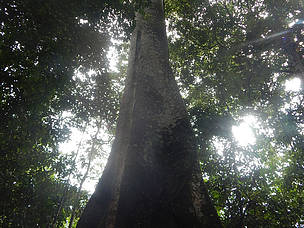By Louvier Kindo Tombe on Special Assignment in Ebodje, South Region of Cameroon
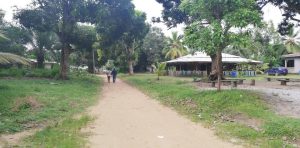
The Chief of Ebodje had just finished meeting with some administrative authorities when we met him sitting in front of his palace in the company of two of his close collaborators. He received us happily as we approached but the joy was short-lived as his mode changed immediately we mentioned the Iron Ore Mining Project in his community.
“We are preparing to start digging our graves”, Chief Ndjokou – Djongo, of Ebodje village told us, referring to the consequences of planting the Iron Ore Mining Project in his community.
Ebodje is located on the Atlantic coast in the Campo Sub Division, some 90 kms away from Kribi in the Ocean Division of the South region.
Made up of a population of above 2000 inhabitants (mainly minority Yassa people), Ebodje is one of the localities where the Chinese company (SINOSTEEL) through its subsidiary Sinosteel Cam SA, is preparing to exploit the Lobé Iron Deposit.
The mining convention was signed between the Minister of Mines, Industry and Technological Development (MINMITD), Gabriel Dodo Ndoke and the General Administrator of Sinosteel Cam SA, Zheng Zhenghao.
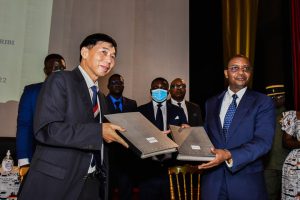
The Chinese company has equally received exploitation permit from the President of the Republic of Cameroon, Paul Biya, and the project is expected to go operational any time soon.
“We cannot counter the decision of the Head of State, we tried to prevent the project to no avail, now we only have our eyes to cry”, Chief Ndjokou Djongo recounts.
About 85% of the land reserved for the project is found in Ebodje, entry village to the Campo Sub Division, South region of Cameroon. The main project site (Mount Mamelles) is a very strategic and important location to the highly populated indigenous “Yassa” people in Ebodje, who are afraid that their future is blurred with the coming of the mining project.
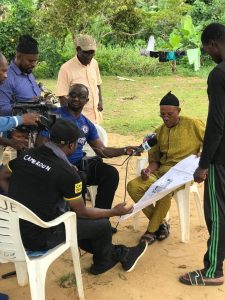
“We are just being cautious with what we don’t master yet”, says Joel Wamba, a native of the village, who joined us at the palace square as we were discussing with the Chief of Ebodje on the impact of the project to the community.
A Step in the Wrong Direction
During our trip to Ebodje, most of those we met had little or no idea about the Iron Ore Mining Project.
“If we don’t know anything, how can we understand the project”, another native of the village said.
Even Chief Ndjokou Djongo, one of the few who have attended some meetings with officials spearheading the project still has so many unanswered questions in his mind concerning the implementation of the project and what they stand to benefit.
“Specifications of the project were only presented to me years after, I don’t know who represented my village in the process”, he said.
“The few meetings that I have attended, I was considered a ‘rebel’ because I always try to defend the rights of my community in the project”, the Chief added.
The Ebodje community is complaining that the iron deposit is found mainly in their land, but they are being undermined and are not going to benefit positively from the project. On the contrary it will impact their livelihoods negatively.
In June 2022, media reports have it that officials from Sinosteel Cam SA visited the Campo Sub Division to throw more light on the mining project.
“We have come to tell you the truth and nothing but the truth”, says Paul Gweth, adviser to the mining project, adding that “the truth is that we will all benefit from the project.”
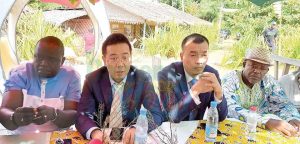
As part of their project dub ‘Land and Corruption in Africa (LCA II) which is in its second phase, Transparency International has multiplied efforts to see that the rights of the communities affected by the project are respected to the fullest.
The international organization has worked with the different parties involved in the mining project, and within the framework of a corporate land grab. Their vision is for the state of Cameroon and the exploitation company (SINOSTEEL) to guarantee respect of the rights of the affected communities.
Since late November in Ebodje, the commission charged with managing indemnities to those affected by the project is carrying out census of persons and evaluation of materials involved.
According to the president of the commission who doubles as Senior Divisional Officer (SDO) of the Ocean Division, Nouhou Bello, the exercise was officially launched on Wednesday November 23, 2022, and will continue until everyone/everything is identified.
“This is a good idea, but why is it coming now, when the exploitation permit has already been signed out”, Chief Ndjokou Djongo laments.
To him, “it was but proper for the feasibility studies and census to be done before the government goes on to sign the exploitation permit.”
This he says is the gateway to corruption and other vices that will follow in the implementation of the project. The census however is facing challenges as many are those rushing to get compensated even for what they never had.
“I don’t recognise some land titles from individuals in my community”, Chief Ndjokou told this reporter.
According to the traditional ruler, some people for one reason or another hurriedly acquired lands in Ebodje and obtained land titles immediately they had idea that government is set to compensate all those affected by the project. I was never contacted in such deals. Again the funny part is that some of these titles conflict.
“How can a land title be given to individuals within a recognised UFA“, Chief Ndjokou questioned, adding that “most of those with such titles are not even true indigenes of Ebodje.”
Chief Ndjokou Djongo, continue to insist that such titles are fake and should not be considered by the powers that be.
Besides issues of fake or invalid land titles, the commission headed by the SDO and charged with managing indemnities had stated clearly in a communiqué that only those with a valid identification paper (National Identity Card, Land Titles…) would benefit from the state’s compensation.
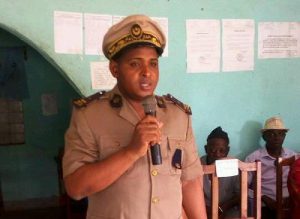
“They are just trying to make life difficult for us, we have some community titles in Ebodje involving many people, how would that be managed when only part of the said area is affected by the project”, the traditional ruler explained.
The people of Ebodje believe this is abuse of compensation for landowners.
However, the decree n° 2003/418 PM of February 25, 2003 in its article 1 stipulates that: The owner victim of expropriation for cause of public utility and destruction of cultivated trees and/or food crops, benefits from a compensation allocated by the legal person benefiting from the expropriation and calculated on well defined basis…
It is necessary to understand that compensation on land declared to be of public utility concerns both ‘titled and untitled’ lands. In other words, there is not only the land to be compensated but there are also crops and other produce on the land.
“In this case, two sub-commissions intervene. The cadastre for the land title and agriculture for crops.
At the level of the agriculture sub-committee, we look at the plant, its value, its age and we set the amounts. For those who do not have a land title, only the agriculture sub-committee intervenes to make the same assessment”, a land survey expert, who preferred not to be named told News Upfront.
“The difference will appear in the envelopes of compensation, for the one who has a land title, he will have the compensation of the land then that of the crops, while the other will only have that of the crops”, he added.
The good news is that the ‘Yassa’ people would not be chased away from their residential areas.
“When I first heard about the iron ore project, I know they will send us away from our homes, but the SDO and his collaborators has assured us that the project site will not reach the village setting”, a native of Ebodje who attended the launching of the census exercise told News Upfront.
“The iron deposit may not be inside the village, but the effects will no doubt meet us in the village and beyond”, Chief Ndjokou Djongo told this reporter.
The cries of the ‘Yassas‘ in Ebodje is for the powers that be to rethink the next stages of the project and consider the interest of the indigenous community, whose future would be greatly affected.
They are Taking Away our ‘Gold Mind’ – Chief Ndjokou Djongo
The Kribi Deep Seaport is just some few kilometres away from Ebodje, same as the Camvert project in Campo, both having devastating effects on the environment. Now with the Iron Ore Mining Project in the heart of the village, everyone is of the opinion that things would get worse.
“We are just like living corpses waiting for the right moment to go”, says Chief Ndjokou.
The traditional ruler strongly believe that the project is coming with a lot of negative effects on the population. The three sister mountains (Mount Mamelles) in Ebodje where the iron deposit has been identified is considered as the main source of livelihood in the community (their so called Gold Mind).
“That site is our main waterbed, the activities of Sinosteel Cam SA would no doubt pollute water that runs across the village, and we shall feel the effects health-wise, agriculturally and otherwise”, says Chief Ndjokou.
The project will definitely need enough water and in the process the waste water would be sent back to the community containing iron residues dangerous to humans, plants and animals. It would definitely affect acquatic life.
“Presently, I can barely catch a basin of fish because the water polluted by the Kribi Deep Sea Port project has caused fishes to change locations, what will happen when Sinosteel Cam SA starts work directly in our village?”, A fisherman in Ebodje, who just returned with an empty catch questioned.

Most of the ‘Yassa’ people are fishermen and farmers to a small extent. They see the project as a threat to their activities.
“Most of us can’t farm again because wild animals constantly leave the forests to destroy our crops. We live on fishing and we fear the project would totally drive away fishes from the sea”, a fisher woman said almost in tears.
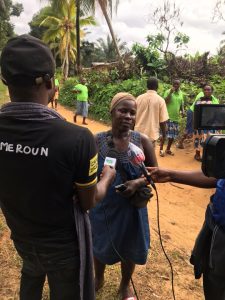
The impact she said would be felt mostly by the younger generation. “I don’t know if my daughter will live up to my age (52) in this village, I don’t know if she can even give birth in this village with all these challenges,” she added.
The challenges are just many according to Chief Ndjokou Djongo.
“From my little knowledge, I see that cancer, especially lung cancer will gradually find its way into my community when the mining project goes operational including other health hazards”.
“Even our traditional doctors who mostly harvest herbs from the three sister mountains (Mount Mamelles) would not have where to harvest herbs again to treat our people”, we were told.
Ebodje Community Facing Extinction
“The iron mining project will destroy our culture and tradition”, Jude, a native of Ebodje said.
During our stay in Ebodje, we were made to understand that one of the most important traditional rights of the community is usually performed on the three sister mountains (Mount Mamelles), precisely inside the “Cave of Bats”.
“That is the main iron deposit and we shall be deprived access to the site which will eventually be destroyed in the process”, Jude said.
A people without a tradition is like they don’t exist at all.
“This great village you see today might not exist in the future”, Chief Ndjokou said, pointing fingers at the different major projects planted in the village and which pose a threat to the livelihoods of his people.
“The projects are slowly but steadily encroaching into the community”. “You may like to know that a fourth project is announced again still in this community with similar effects on the environment and inhabitants.”
If Ebodje is known worldwide today, it is because of its ecotourism potential, close to the Campo Ma’an National Park, found in the UNESCO heritage list, and also near the Marine Park of ‘Manyangué na Elombo’ where several species of sea turtles live.
“The number of turtles we used to see here have greatly reduced owing to pollution in the sea”, says Joel Wamba, from an association protecting the different species of turtles.
The association is known as “Tube Awu“, loosely translated in English as “Our Ocean”.
Ecotourism is the main source of income to the community.
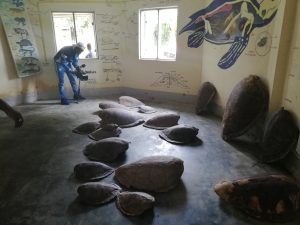
“I don’t think we would be able to welcome tourists again when the mining project starts, because water pollution will likely chase away all the tutles in our community”, Chief Ndjokou said.
This project to him “will truly affect our community.”
The Way Forward
“The exploitation permit for the mining project has been given already, we can only plead with the power that be to respect the terms contained in the specification documents”, the Chief said.
Transparency International is poised to contribute her own quota to see that the rights of the indigenous communities are respected in the process.
One of the immediately aspect that the international organization looks up to is the issue of compensation to those affected, especially as in Cameroon now to obtain a land title is a tug of war.
The organization is of the opinion that considerations should be given to those who have been exploiting thier lands for years without a title.
Experts believe that the exploitation company Sinosteel Cam SA, on her part, aware of the environmental challenges that the project will provoke, should be thinking of how to reduce or mitigate the effects on the host community, environmentally and otherwise.
The Mining Project in Figures
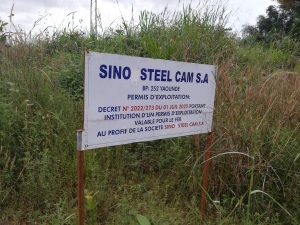
According to the Minister of Mines Industry and Technological Development (MINMITD), Gabriel Dodo Ndoke, the current mining project is a win-win convention hat the state of Cameroon has signed and which will contribute significantly to the development of the economy of the country.
The project is expected to generate at least 600 direct jobs and 1.000 indirect jobs.
Under the terms of the deal between the government and Sinosteel Cam SA, The exploitation company will mine 10 million tons of iron ore, with 33% iron content annually.
The contract according to sources give Sinosteel Cam SA, a 50 – year claim on the ‘Lobe Mine’ which is said to hold about 632.0 million metric tons of high-grade iron ore.
The convention allows for 15% of the iron ore to supplied to the local market, but Cameroon could authorise Sinosteel Cam SA to export it if local demand is weak.
The project would be 30% self funded, with 70% of the financing coming from bank loans.
The minister of Mines Industry and Technological Development indicates that the specification documents hold Sinosteel Cam SA to build schools , hospitals, roads, and a 20-kilomater-long pipeline move the ore from Lobe to the Port in Kribi, a coastal city in the South region of Cameroon. Sinosteel Cam SA also agrees to enrich the iron ore from 33% to 60%, which will drastically improve its market value.
The deadline for the project to go operational is yet to be announced by Sinosteel Cam SA, but under Cameroon’s Mining Code, the company must begin the project within five (5) years from the the day the mining permit is granted.




